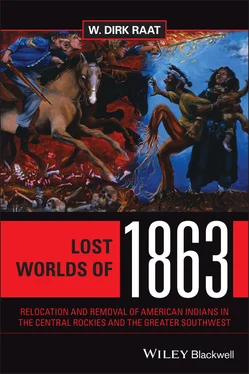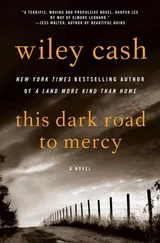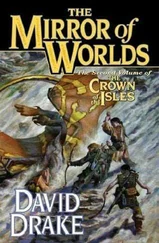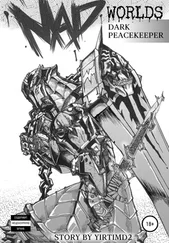In early colonial days Englishmen made war captives out of the Indians of the southeastern parts of the United States and forcibly sent them through the port of Charleston to slavery in the plantations of the West Indies. Between 1770 and 1810, Spanish soldiers escorted three thousand Apache “prisoners-of-war” to Mexico City. Women and children became domestics in central Mexico, while the Apache men were sent to work the fields and ports of Cuba. By the nineteenth century Mexican slave traders were busy kidnapping Navajo women and children to serve as domestics and laborers in the fields and homes of New Mexico. A similar situation occurred in California. Slavery or “servitude” was justified on the grounds that the uncivilized savages were having their souls saved by the actions of Christian overseers.
As for the use of the words “genocide” and “holocaust,” because of the volatility of these words I have use them sparingly. In some instances, where extermination was not the object but land acquisition was, “ethnic cleansing” may be the preferred phrase. This study follows the definitions of genocide of the Proposed Convention on Prevention and Punishment of the Crime of Genocide (1997) intended to supersede the United Nations Convention of 1948. Genocide, by these definitions, may be threefold: Physical (deliberate and direct or indirect killing of a specific ethnic or racial group); Biological (including sterilization and psychological conditions leading to birthrate declines and increased rates of infant mortality); and Cultural (eradication of the mores, habits, traditions, and languages of a specific group).
Obviously, under these definitions genocide has a long history in Asia and America in addition to and outside of Europe and Nazi Germany. According to James W. Loewen, author of Lies My Teacher Told Me , “Hitler admired our concentration camps for American Indians in the west and according to John Toland, his [Hitler’s] biographer, [Hitler] ‘often praised to his inner circle the efficiency of American extermination—by starvation and uneven combat as the model for his extermination of Jews and Gypsies’.” 5In 1928 Hitler approvingly noted that white settlers in America had “gunned down millions of redskins” and had America in mind when he spoke of “living space” or Lebensraum in Eastern Europe. 6
Genocide is a form of violence that involves killing. Battles and massacres are not necessarily genocidal events unless the battle is transformed into a massacre and the intentional killing evolves into a pattern targeting a particular ethnic, racial, or religious group. But genocide of the American Indian is part of the historical record, and as my dear friend and colleague from Fredonia State University, the late historian William T. Hagan, asserted, “ Genocide is a term of awful significance, but one which has application to the story of California’s Native Americans” (and, I may add, the indigenous population of parts of the Greater Southwest in general). 7
In June of 2020 the “Black Lives Matter” movement included a few marchers holding “Indigenous Lives Matter” signs. The demonstrators, in support of the Black Lives protestors, reminded the nation that while Native Americans consist of only 0.8% of the population, they experience 1.9% of police killings (data from the Centers for Disease Control and Prevention between 1999 and 2011).
At the same time in St. Paul, Minnesota a statute of Christopher Columbus was brought down by protestors. Columbus, whose legacy for indigenous America was one of slavery and genocide, was removed from the public sphere. As cultural theorist Gerald Vizenor states, “Columbus and his civilization would discover no salvation in the New World. The missions, exploitations, racial vengeance, and colonization ended the praise of deliverance; the conquistadors buried the tribal healers and their stories in their blood.” 8
Brendan Lindsay has noted in his book Murder State that “When one considers the actions of the press, state and federal governments, and the citizenry as a whole, the result was the creation of an inescapable system of democratically imposed genocide … devised to fulfill the demands of the newly minted citizenry of California.” 9Larissa Behrendt continued this theme by arguing that indigenous people’s claims of state-sanctioned genocide are still being defeated by legal traditions that reflect a legacy of colonialism and violence. 10
Under these definitions and usages the California massacres, the Bear River Massacre, the Sand Creek Massacre, the Yaqui deportations, and the events at Wounded Knee would be described as “genocidal,” while the removal of Paiutes, Navajos, Mescaleros, Chiricahua Apaches, and Yavapai would be “ethnic cleansing.” Certain writers, like David E. Stannard (see below), or some of those cited above, may not agree with this distinction. As Stannard and others have noted, most white Americans thought in terms of expulsion or extermination, and they were not necessarily mutually exclusive options. Some forced marches were literally “death marches.” The early years of the Indian Boarding School experiment might be called an attempt at “cultural genocide.”
As for “holocaust,” the word was used generally in English to denote devastation and massacres. Since 1945 most scholars, with the exception of David E. Stannard, use it to refer specifically to the Nazi genocide of Jews and others. Stannard, in his excellent and comprehensive study of the extermination of American Indians, speaks freely of an American Holocaust . Stannard’s holocaust included the interdependent forces of disease and genocide (including slavery and racism) that brought a deadly end to the lives of nineteen out of twenty Indians between 1492 and the end of the nineteenth century. 11
“Holocaust” is used in “Lost Worlds” in the generic sense to refer to the massacre and devastation of American Indians by non-Indians. Whether the word(s) or phrase is “holocaust,” “genocide,” “war crimes,” or “ethnic cleansing,” all would be considered criminal actions today. These and related matters will be discussed further in the Epilogue.
As dark as these themes are, it should be remembered that the indigenous peoples survived these episodes and are active today. One aspect of that survival is the current state of Indian “fine arts,” and artist Alan Houser, among others, represents that survival instinct of the Native American. The holdings of the Heard Museum in downtown Phoenix, Arizona, reflect that side of the story.
Another recent change is the confirmation of Rep. Deb Haaland (Democrat/N.M.) to become secretary of the Department of Interior by President Joe Biden on March 15, 2021. The Department of Interior includes the Bureau of Indian Affairs. Haaland is a member of the Laguna Pueblo, one of the nineteen Pueblo communities in New Mexico. She is the first Native American to hold such a position. In a country in which the median income of on- and off-reservation Indians is $40,315 (between 2013–2017), compared to $66,943 for all Americans, Haaland is in a position to restore tribal sovereignty, renew reservation economies, improve conservation, and move the country’s Native Americans away from dependency to independence. 12
This work, therefore, is a tribute to those few tribes that inhabit the Greater Southwest. In 2016 there were 566 federally recognized tribes in the United States. State recognized tribes amount to 130. California tribes or rancherías number 108. Arizona has 22 federally recognized Indian communities. While the total indigenous population residing on the reservations may be close to 2.9 million (with another 3 plus million off the reservation), and even though part of their land and identities has been restored, only 2% of the topography of the United States is Indian Country today. The narrative of this work is primarily focused on that time when close to 100% of the terrain of the Southwest was Indian Country (see map, Figure 0-1). The colonizer’s “holocaust” changed all of this by creating the “Lost Worlds of 1863.”
Читать дальше












